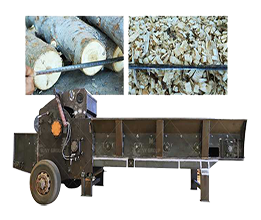How to choose Wood Chipper?
A wood chipper is a powerful tool for managing yard waste, clearing land, and efficiently utilizing woody debris. Whether you’re a small homeowner needing to clear backyard brush or a professional dealing with large volumes of branches, choosing a wood chipper that suits your needs is crucial.
What are the key factors to consider when choosing a wood chipper?
1. Chipping capacity (maximum processing diameter)
This is one of the most important considerations. Chipping capacity refers to the maximum wood diameter that the chipper can handle. Make sure the maximum processing diameter of the chipper is slightly larger than the size of wood you normally need to handle to prevent overloading the machine and improve efficiency.
2. Power source and engine horsepower
The power source of the chipper (electric or gasoline) directly affects its performance and range of use.
Electric chippers: Pay attention to the motor power (watts or amps). The higher the power, the greater the processing capacity.
Gasoline chippers: Engine power is usually measured in horsepower (HP) or cubic centimeters (CC). The higher the HP or CC number, the more powerful the machine is and the better it can handle coarse wood.
3. Feed system
The feed system of the chipper determines the ease and safety of wood entering the machine.
Automatic feed system: Some high-end chippers are equipped with automatic feed rollers that pull wood into the shredding mechanism, greatly improving efficiency and safety.
Manual Feed: Most home chippers are manually fed, requiring the user to push the wood into the feed chute. Make sure the feed opening is large enough for easy operation and provides adequate safety distance.

4. Blades and Shredding Mechanism
The chipper’s shredding efficiency and the fineness of the final product depend on its blades and shredding mechanism.
- Impact Blades (Drum or Disc): These chippers use blades that rotate at high speeds to shred wood, usually for tree branches.
- Drum Chippers (Smashing): This mechanism pulverizes and tears wood, produces finer wood chips, is quieter, and works better with soft materials such as leaves. Drum chippers are generally lower maintenance because they are more tolerant of foreign matter, such as rocks.
- Multi-Purpose Systems: Some chippers combine two mechanisms, one for shredding tough branches and another for leaves and fine debris.
Consider blade material and replaceability. High-quality blades last longer, while replaceable blades reduce maintenance costs.
5. Portability and Storage
If you need to move the chipper frequently, its weight, wheels, and handle design are crucial. Large chippers often come with pneumatic tires to make it easier to move over uneven terrain. Consider storage space when the chipper is not in use.
6. Safety Features
Wood chippers are powerful machines, and safety is of utmost importance. Look out for the following safety features:
- Emergency stop button: This instantly shuts down the machine in an emergency.
- Anti-rebound design: This prevents wood from rebounding during the feeding process, which can cause injury.
- Safety interlock: This ensures that the machine will not start if certain parts, such as the feed chute cover, are not closed properly.
- Goggles and gloves: Always wear appropriate personal protective equipment when operating a wood chipper.
7. Brand and user reviews
Look for a reputable brand that provides information about the machine’s performance, durability, and customer support.
8. Budget
Wood chippers vary widely in price. Before you start choosing, determine your budget. Keep in mind that higher-priced models generally offer higher chipping capacity, more durable construction, and more features.
Choosing the right wood chipper requires you to comprehensively consider factors like chipping capacity, power source, feeding system, safety features, and your budget.
Contact Us
Address
Henan Communication Industrial Park, Economic Development Zone, Zhengzhou City, Henan Province, China

